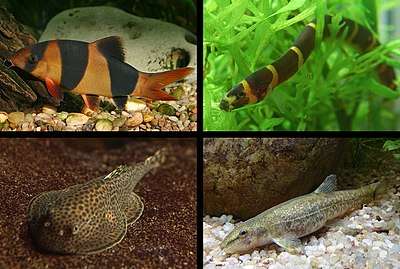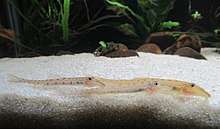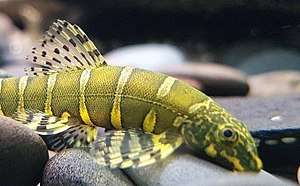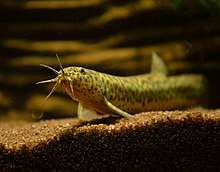Loach
Loaches are fish of the superfamily Cobitoidea. They are freshwater, benthic (bottom-dwelling) fish found in rivers and creeks throughout Eurasia and northern Africa.[1] Loaches are among the most diverse groups of fish; the 1249 known species of Cobitoidea comprise about 107 genera divided among nine families.[2][3]
| Loaches | ||||||
|---|---|---|---|---|---|---|
  | ||||||
| Examples of several loach families | ||||||
| Scientific classification | ||||||
| Kingdom: | Animalia | |||||
| Phylum: | Chordata | |||||
| Class: | Actinopterygii | |||||
| Order: | Cypriniformes | |||||
| Superfamily: | Cobitoidea Swainson, 1838 | |||||
| Families | ||||||
| ||||||
Description

Loaches display a wide variety of morphologies, making the group difficult to characterize as a whole using external traits. They range in adult length from the 23 mm (1 in) miniature eel-loach, Pangio longimanus, to the 50 cm (20 in) imperial flower loach, Leptobotia elongata, with the latter weighing up to 3 kg (6.6 lbs).[4][5][6] Most loaches are small, narrow-bodied and elongate, with minute cycloid scales that are often embedded under the skin, patterns of brown-to-black pigment along the dorsal surface and sides, and three or more pairs of whisker-like barbels at the mouth.[7] The type species of the family Cobitidae, Cobitis taenia, has a body shape and pigment pattern typical of Cobitoidea. However, many loaches are eel-like or conversely, quite stout-bodied; some balitorids have large, visible scales.[8]
Loaches in the families Cobitidae, Botiidae, and Serpenticobitidae possess a bifid, protrusible spine below the eye, or in the case of the genus Acantopsis, between the eye and the tip of the snout.[9][10]
Taxonomy and systematics
_(7064407839).jpg)
Etymology
The name Cobitoidea comes from the type genus, Cobitis, described by Carl Linnaeus in his landmark 1758 10th edition of Systema Naturae. However, its origin predates modern zoological nomenclature and derives from a term used by Aristotle to refer to "small fishes that bury... like the gudgeon."[1]
Classification
Cobitoidea is a superfamily within the order Cypriniformes, one of the most diverse groups of vertebrates. The order is commonly known as "minnows, carps, loaches, and relatives," and it includes the suckers (Catostomidae) and algae eaters (Gyrinocheilidae). Fishes of the latter family, which contains only a single genus Gyrinocheilus, are sometimes referred to as sucking loaches. It is uncertain if Gyrinocheilidae, or a clade containing both Gyrinocheilidae and Catostomidae, is sister to Cobitoidea.[11]
History of classification
At the turn of the 20th century only two families of loaches had been described, and of these only Cobitidae was widely recognized by taxonomists. In the early 1900s, the American ichthyologist Fowler and the Indian ichthyologist Hora recognized what would come to be known as Balitoridae and Gastromyzontidae.[12][13] Nemachelidae, and later Botiidae, were described as subfamilies of Cobitidae until their elevation to family status in 2002.[14][15][16] Owing to shared morphological characteristics (see osteology, below) the relationship of the botiid and cobitid loaches was particularly difficult to resolve until the advent of molecular phylogenetics. Three of the nine families, containing only two or three species apiece, were recognized within the last ten years.[11]
Phylogeny
Reproduction of molecular phylogeny of Cobitoidea from Bohlen & Šlechtová, 2009,[17] with common names following Eschmeyer's Catalog of Fishes.[18]

| ||||||||||||||||||||||||||||||||||||||||||||||||||||
Osteology
Among loaches, the majority of known morphological synapomorphies (shared characters derived from a common ancestor) are osteological. In particular, modifications to the ethmoid and surrounding bones within the neurocranium unite Cobitoidea, in addition to certain lateral-line canal ossifications.[7] An erectile suborbital spine, a modification of the lateral ethmoid, was formerly thought to represent a synapomorphy between Cobitidae and Botiidae.[19] It is now considered a pleisiomorphy of Cobitoidea, a character shared by the common ancestor but lost in most loach lineages.[20] The suborbital spine is also retained in the serpent loaches, Serpenticobitidae.[9]
Habitat and distribution
Loaches are found in a wide variety of habitats throughout Europe, northern Africa, and central and Southeast Asia. Most families occur predominantly in rocky mountain streams at high elevations, but almost all have lowland representatives as well.[1] Many species of Cobitidae burrow in the sand and inhabit riverbeds in broad, flat terrain. At least three families contain blind, troglomorphic species adapted to life in caves.
Relationship with humans

Some loaches are important food fish, especially in East and Southeast Asia where they are a common sight in markets.
Loaches are popular in the aquarium trade. Some of the most well-known examples are the clown loach (Chromobotia macracanthus), the kuhli loach (Pangio kuhlii), and the dwarf chain loach (Ambastaia sidthimunki). Botiid and gastromyzontid loaches also occasionally make their way into the trade.[21]
Although loaches have a strictly Old World native distribution, the oriental weatherfish, Misgurnus anguillicaudatus, (also known as the dojo loach) has been introduced in parts of the United States.[22][23]
References
- Kottelat, M. (2012). "Conspectus cobitidum: an inventory of the loaches of the world (Teleostei: Cypriniformes: Cobitoidei)". The Raffles Bulletin of Zoology. Supplement no. 26: 1–199.
- Fricke, R.; Eschmeyer, W. N.; van der Laan, R., eds. (2019). "Eschmeyer's catalog of fishes: genera, species, references". Electronic version accessed February 2019.
- Nelson, J. S.; Grande, T. C.; Wilson, M. V. H. (2016). Fishes of the World (5th ed.). Hoboken, New Jersey: John Wiley & Sons. pp. 189–193. ISBN 978-1-118-34233-6.
- Britz, R.; Kottelat, M. (2009). "Pangio longimanus, a miniature species of eel-loach from Central Laos (Teleostei: Cypriniformes: Cobitidae)". Ichthyological Exploration of Freshwaters. 20 (4): 371–376. ISSN 0936-9902.
- Li, L.; Wei Wei, Q.; Ming Wu, J.; Zhang, H.; Liu, Y.; Xie, X. (2015). "Diet of Leptobotia elongata revealed by stomach content analysis and inferred from stable isotope signatures". Environmental Biology of Fishes. 98 (8): 1965–1978. doi:10.1007/s10641-015-0414-4.
- Nichols, J. T. (1943). The Freshwater Fishes of China—Central Asiatic Expeditions. New York: American Museum of Natural History. p. 203.
- Conway, K. W. (2011). "Osteology of the South Asian genus Psilorhynchus McClelland, 1839 (Teleostei: Ostariophysi: Psilorhynchidae), with investigation of its phylogenetic relationships within the order Cypriniformes". Zoological Journal of the Linnean Society. 163: 50–154. doi:10.1111/j.1096-3642.2011.00698.x.
- Kottelat, M. (1988). "Indian and Indochinese species of Balitora (Osteichthyes: Cypriniformes) with descriptions of two new species and comments on the family-group names Balitoridae and Homalopteridae". Revue Suisse de Zoologie. 95 (2): 487–504. doi:10.5962/bhl.part.79667.
- Bohlen, J.; Šlechtová, V.; Šlechta, V.; Šlechtová, V.; Sember, A.; Ráb, P. (2016). "A ploidy difference represents an impassable barrier for hybridisation in animals. Is there an exception among botiid loaches (Teleostei: Botiidae)?". PLoS ONE. 11 (7): e0159311. Bibcode:2016PLoSO..1159311B. doi:10.1371/journal.pone.0159311. PMC 4956246. PMID 27442252.
- Boyd, D. A.; Nithirojpakdee, P.; Deein, G.; Vidthayanon, C.; Grudpan, C.; Tangjitjaroen, W.; Pfeiffer, J. M.; Randall, Z. S.; Srisombat, T.; Page, L. M. (2017). "Revision of the horseface loaches (Cobitidae, Acantopsis), with descriptions of three new species from Southeast Asia". Zootaxa. 4341 (2): 151–192. doi:10.11646/zootaxa.4341.2.1. PMID 29245684.
- Armbruster, J. W.; Tan, M. (2018). "Phylogenetic classification of extant genera of fishes of the order Cypriniformes (Teleostei: Ostariophysi)". Zootaxa. 4476 (1): 6–39. doi:10.11646/zootaxa.4476.1.4. PMID 30313339.
- Fowler, H. W. (1905). "Some Fishes from Borneo". Proceedings of the Academy of Natural Sciences of Philadelphia. 57: 455–523. JSTOR 4063033.
- Hora, S. L. (1932). "Classification, bionomics and evolution of homalopterid fishes". Memoirs of the Indian Museum. 12 (2): 263–330.
- Liu, H.; Tzeng, C. S.; Teng, H. Y. (2002). "Sequence variations in the mitochondrial DNA control region and their implications for the phylogeny of the Cypriniformes". Canadian Journal of Zoology. 80 (3): 569–581. doi:10.1139/z02-035.
- Tang, Q.; Liu, H.; Mayden, R.; Xiong, B. (2006). "Comparison of evolutionary rates in the mitochondrial DNA cytochrome b gene and control region and their implications for phylogeny of the Cobitoidea (Teleostei: Cypriniformes)". Molecular Phylogenetics and Evolution. 39 (2): 347–357. doi:10.1016/j.ympev.2005.08.007. PMID 16213167.
- Liu, S.; Mayden, R.; Zhang, J.; Yu, D.; Tang, Q.; Deng, X.; Liu, H. (2012). "Phylogenetic relationships of the Cobitoidea (Teleostei: Cypriniformes) inferred from mitochondrial and nuclear genes with analyses of gene evolution". Gene. 508 (1): 60–72. doi:10.1016/j.gene.2012.07.040. PMID 22868207.
- Bohlen, J.; Šlechtová, V. (2009). "Phylogenetic position of the fish genus Ellopostoma (Teleostei: Cypriniformes) using molecular genetic data". Ichthyological Exploration of Freshwaters. 20 (2): 157–162. ISSN 0936-9902.
- Van der Laan, R.; Fricke, R.; Eschmeyer, W. N., eds. (2019). "Eschmeyer's catalog of fishes: classification". Electronic version accessed February 2019.
- Sawada, Y. (1982). "Phylogeny and zoogeography of the superfamily Cobitoidea (Cyprinoidei, Cypriniformes)". Memoirs of the Faculty of Fisheries Sciences, Hokkaido University. 28 (2): 65–223.
- Šlechtová, V.; Bohlen, J.; Tan, H. H. (2007). "Families of Cobitoidea (Teleostei; Cypriniformes) as revealed from nuclear genetic data and the position of the mysterious genera Barbucca, Psilorhynchus, Serpenticobitis and Vaillantella". Molecular Phylogenetics and Evolution. 44 (3): 1358–1365. doi:10.1016/j.ympev.2007.02.019. PMID 17433724.
- Loaches: natural history and aquarium care. Neptune City, NJ: T.F.H. Publications. 2008. ISBN 9780793806201.
- Fuller, P. L.; Nico, L. G.; Williams, J. D. (1999). Nonindigenous fishes introduced into inland waters of the United States. Bethesda, MD: American Fisheries Society, Special Publication #27. p. 176.
- Robins, R. H.; Page, L. M.; Williams, J. D.; Randall, Z. S.; Sheehy, G. E. (2018). Fishes in the fresh waters of Florida: an identification guide and atlas. Gainesville, Florida: University of Florida Press. pp. 141–142. ISBN 9781683400332.